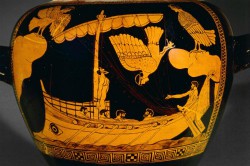Trending Science: Scientists discover world’s oldest intact shipwreck
A team of maritime archaeologists, scientists and surveyors who unearthed the oar- and sail-powered vessel say that it appears to have lain undisturbed for more than 2 400 years. The 23-metre Greek trading ship’s design had been seen only on ancient pottery. For the past three years, the joint Anglo-Bulgarian venture known as the Black Sea Maritime Archaeology Project (MAP)(opens in new window) has been mapping the Bulgarian waters of the Black Sea where dozens of ships lie on its seabed. It’s one of the largest multidisciplinary maritime archaeology projects ever attempted. Black Sea MAP’s mission is to explore the area using sonar and deep-sea diving remotely operated vehicles (ROVs). With some 60 shipwrecks discovered until now, the team hopes to uncover more intact shipwrecks and ancient settlements that help to reveal how human civilisation has evolved. In late 2017, Black Sea MAP found the wreck off the Bulgarian coast lying about 2 km below the surface. Its mast, rudders and rowing benches were all intact and remarkably well preserved. It remained in such good condition because there’s no oxygen at that depth. A game changer for ancient maritime heritage “A ship, surviving intact, from the Classical world, lying in over 2 kilometers of water, is something I would never have believed possible,” Black Sea MAP principal investigator Jon Adams, a maritime archaeology professor at the University of Southampton, told ‘CNN’(opens in new window). “This will change our understanding of shipbuilding and seafaring in the ancient world.” “There are ships down there that have never been seen apart from in murals and paintings and in books, and this is the first time they have been seen since they were afloat,” said Edward Parker, CEO of Black Sea MAP. The Black Sea MAP expedition believes the ship was a type of trading vessel that has only previously been seen on the side of ancient Greek pottery such as the British Museum’s Siren Vase. The celebrated vase bears Odysseus secured to his ship’s mast as it sails past three mythical sea nymphs whose tune was thought to drive sailors to their death. The team thinks the wreck dates back possibly 100 years after the Siren Vase was painted. They never expected to see a ship so old. “It’s like another world,” said Dr Helen Farr from the expedition in an interview with ‘BBC’(opens in new window). “It’s when the ROV … drops down through the water column and you see this ship appear in the light at the bottom so perfectly preserved it feels like you step back in time.” The ancient Greek ship’s cargo remains a mystery for now. Black Sea MAP plans to return to the site when it secures more funding. It shouldn’t be long before Black Sea MAP journeys to the depths of the Black Sea once again to shed light on the ancient world’s shipbuilding and seafaring. “As archaeologists we’re interested in what it can tell us about technology, trade and movements in the area,” added Dr Farr. A 2-hour documentary on the project opened 23 October at the British Museum.
Countries
Bulgaria, United Kingdom



